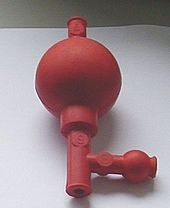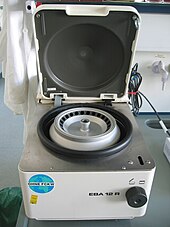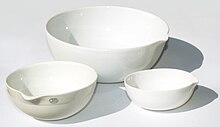Laboratory device

1 stirring bar / boiling chips
2 round bottom flask with distillation svorlage
3 + 8 + 9 water (with 3 rectification column , 8 burettes unit and 9 drain valve )
4 thermometer
5 cooler
6 cooling water -Zulauf
7 cooling water outlet
10 collection vessel (Round bottom flask with distillate)
Under laboratory equipment means all in a laboratory vessels used, tools and other aids.
Chemistry laboratories
In chemistry, laboratory equipment refers to all vessels, tools and other aids used in the chemistry laboratory that are used to carry out chemical processes such as syntheses or analyzes .
There are a number of special devices for use in the chemistry laboratory. These are particularly characterized by the fact that they are made of very resistant materials , as they are exposed to many different, often aggressive chemicals and sometimes extreme temperatures . The main use here is glass , in particular borosilicate glasses , which are characterized by a low coefficient of thermal expansion and are therefore insensitive to sudden temperature fluctuations. In addition to being insensitive to acids, alkalis and heat, the advantages of glass are its transparency and the ability to manufacture individually adapted devices or to repair broken devices through glass blowing . Other materials are porcelain , fluorinated plastics such as PTFE ( Teflon ) or PVDF and, more rarely, wood and metals . The latter two are usually only used where little contact with chemicals is to be expected (brackets, tripods).
A modular design is also important for laboratory equipment, so that the individual elements can be put together as desired, as if from a construction kit. This is of particular interest in preparative chemistry, since a suitable apparatus is assembled here depending on the synthesis task.
The flexibility in assembling the glass equipment is achieved through the use of so-called standard cuts . The cut ensures that two glass devices can be joined together in a gas-tight manner. The connection can also be sealed with joint grease or Teflon sleeves and secured with a joint clamp . Larger and unstable apparatuses are fixed with stand material, which consists of vertical metal rods with feet, to which the laboratory devices are held by means of stand clamps.
Glass or plastic vessels
- Beaker
- Dewar flask
- Dosing cylinder
- Erlenmeyer flask
- Gas burette
- Gas generator
- Gas wash bottle or wash bottle
- gasometer
- Cap bottle
- Kjeldahl flask
- Multi-neck flask
- volumetric flask
- Graduated cylinder
- Mixing cylinder
- Petri dish
- Pneumatic tub
- Test tube
- retort
- Round bottom flask
- Reflux condenser
- Feeding bottle
- Separating funnel
- Schlenk vessel
- Pointed butt
- Standing cylinder
- Upright flask
- Dropping funnel
- U-tube
Other glass appliances
- Hydrometers
- Burette , gas burette
- Claisen essay
- Distilling bridge
- Dimroth cooler
- Double spiral cooler
- Desiccator
- Piston sampler
- Spherical cooler
- Cold trap
- Cold finger
- Chick cock
- Cuvette
- Liebig cooler
- Pycnometer
- Reaction tube
- Separating funnel
- Snake cooler
- Boiling capillary
- Soxhlet extractor
- Spiral cooler
- funnel
- Drying tube
- watch glass
- Advance
- Corrugated pipe cooler
- Counting chamber (for counting cells )
Porcelain utensils and tools
Other tools
- Dish rack
- Bunsen burner
- Glass rod
- Rubber wipers ("ion broom" or "molecular broom") for wiping the crucible or another vessel during gravimetry
- Magnetic stir bar ( stir bar )
- tweezers
- Pipetting aid
- pipette
- spatula
- Squirt bottle
- Ground joint
- Stand rod with double socket and clamps
- thermometer
- Crucible tongs
- water bath
- Water jet pump
Electrical appliances
Laboratory equipment industry
The world market for analysis and laboratory technology amounted to around 45 billion US dollars in 2013. The 330 German manufacturers, with around 40,000 employees, generated sales of 6.7 billion euros in the same year, after sales of 6.6 billion euros in 2011 (with a world market of around 40 billion dollars). Domestic sales amounted to € 3.1 billion and foreign sales to € 3.6 billion. Accordingly, the export quota was 54%.
The most important customer sectors for German manufacturers are currently industry, the public sector and the pharmaceutical and chemical sectors. Around 85 percent of domestic sales are generated in these markets. But there are also numerous other sectors and niches in which the companies are successfully asserting themselves. Examples of this are the areas of biotechnology and food. The most important target countries for German exports of analysis and laboratory technology include the USA, China, France, the United Kingdom, Italy, the Russian Federation, the Republic of Korea, Japan, the Netherlands and Switzerland.
Web links
Website of the professional association for analysis, bio and laboratory technology at Spectaris
Individual evidence
- ^ Brockhaus ABC Chemie , VEB FA Brockhaus Verlag Leipzig 1965, pp. 773-779.
- ↑ Manja Wühr: Analysis, bio and laboratory technology on the road to success. Reported to Process from October 17, 2012.
- ^ The German Industry for Analysis, Biotechnology and Laboratory Technology - Yearbook 2014 , Spectaris .





